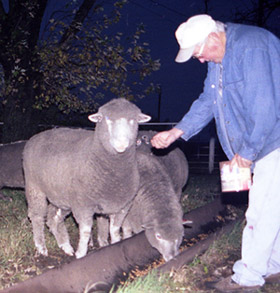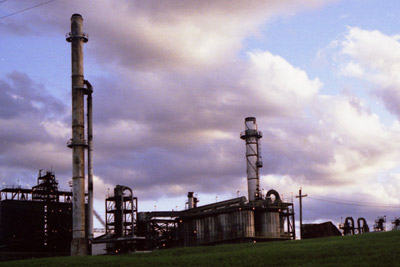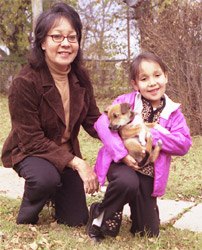Carbon Black
Air Date: Week of July 7, 2006

Continental Carbon plant near Ponca City, Oklahoma (Richard Ray Whitman)
Ever wonder what makes tires black? It's fine pieces of black carbon. But producer Vicki Monks reports that Oklahomans who live near a plant that manufactures the product say they've been left unprotected and it may be time to give an Indian reservation control over environmental regulation.
Transcript
CURWOOD: From the Jennifer and Ted Stanley studios in Somerville, Massachusetts, this is Living On Earth. I’m Steve Curwood. According to the Environmental Protection Agency more than one-third of Americans live in counties with unhealthy levels of soot or small particles in the air they breath. Scientists only recently have begun to understand the dangers of these microscopic particles. They are easily inhaled and can contribute to a host of diseases.
In Oklahoma, near the border of Ponca Indian land, community members say one industrial plant has dumped so much carbon soot into the air their farm animals are changing color. Ponca tribal leaders accuse state and federal officials of ignoring the problem. It's one reason the Poncas and a dozen other Oklahoma tribes have decided that maybe it’s time they had more authority over their air and water. Vicki Monks has the story.
[GATE CLANKING, BUCKET SCRAPING, SHEEP BLEETING]
MONKS: On a small acreage just south of Ponca City, Oklahoma, John Hough runs a herd of white-faced sheep, a breed prized for pure white wool. Problem is, these sheep appear closer to black - an oily, sooty black.
HOUGH: That one right there in the middle, look at her nose, around her nose nostrils, look how black it is. And up past her eyes, see them streaks up past her eyes? That all should be white. It's a pathetic thing to see some kind of an animal like that.

John Hough's white sheep changed color from the carbon dust. (Credit: Vicki Monks
[SHEEP SOUNDS FADING]
MONKS: A stubborn black film covers just about everything on the Hough property - from the tractor to the trees. A short walk across the grass, and I notice that my shoes and pants have collected black dust halfway up to my knees.
HOUGH: We are inhaling it. Everything around us is inhaling it because it's a real fine powdery dust and we're breathing it just as much as them sheep are.
MONKS: Carbon black itself might not seem to be harmful - it's pure carbon, the basic building block of nature - but frequently, other toxic chemicals are attached. The particles can contribute to heart disease, chronic bronchitis and asthma. California last year listed carbon black as a cancer-causing agent.
UCLA Toxicology Professor John Froines is chairman of California's Scientific Review Panel on Toxic Air Contaminants.
According to Professor Froines, it's generally accepted that particles may inflame the lungs, leading to mutations that can develop into cancer. And, new research is finding that ultra-fine particles may damage other parts of the body.
FROINES: It's not just the issue of penetration deeply into the lung. You get them in your nose, as well, and they end up in your brain, and so you have a potential for inflammatory effects in the brain, central nervous system and you have a potential for carcinogenesis, as well.
MONKS: Professor Froines explains that carbon particles lodged inside the body can actually produce other toxic compounds--in a sense, becoming engines that continuously manufacture substances with the potential to cause cancer.
FROINES: So the particles themselves can produce more damage to DNA than you might anticipate.
[LOUD FACTORY WHINE IN BACKGROUND]
 Continental Carbon plant near Ponca City, Oklahoma.
Continental Carbon plant near Ponca City, Oklahoma.
(Credit: Richard Ray Whitman)
MONKS: Continental Carbon's original owner, Continental Oil, Conoco, built this carbon black plant in 1953 on former Ponca Indian reservation land. Back then, Thurman and Thelma Buffalohead lived next door. Thelma says the top man at Continental Carbon assured the family that the company would build a state of the art plant that would never pollute.
THELMA: I said, “Will it get everything black?” “No, no, no, it'll be all right,” he said.
THURMAN: I hate to say it, but that's a lie, telling people that and then it's dirty. I tell you it's dirty, still that way.
MONKS: Thurman Buffalohead has a Ponca word for that.
THURMAN: Eeooshishta - that's what liar means, lying means. Eeooshista and eegah moneeteday. Even that north side of carbon black, there was a stream of clear water. We used to go down there and sit in that creek. But after that you couldn't do that, you'd get yourself black, you know, touching everything down that creek.
MONKS: The Buffaloheads say the land around the creek turned black soon after the plant was up and running, and it wasn't long before the carbon black had gotten into everything.
THELMA: I had some chickens that were white and before I knew it they were black chickens. And you'd wake up with our nose, just all black soot in the nose.
THURMAN: Oh, sister, it's just that smell! It goes into your nostril and I mean you sleep with it, yeah. That's all I could tell you. It gets on your clothes and makes everything black. Eeooshista cha ah, ehdah a gah a la bashi. But they don't care, they still going to lie and lie and lie and lie and that's why we're in trouble, yeah, we're in trouble today.
MONKS: The Buffalohead family lived on part of an Indian allotment that once belonged to Harriet Rush in The Battle. The land had stayed in the family since 1895. But by the 1960s, Mrs. Rush in The Battle's descendants wanted to get away from the plant. They tried to sell the property, but no one wanted it. It was already too contaminated, and documents show the government was aware of the problem.
Richard Ray Whitman reads from a 1969 memo written by the local Bureau of Indian Affairs superintendent:
WHITMAN: “Regarding Ponca allotment 435, Harriet Rush in the Battle. The subject allotment has been offered for public sale on several occasions without success because of heavy contamination from the carbon plant operated by Continental Oil. The owners have demanded some action be taken by the Bureau, therefore, it is requested that an investigation be conducted. James D. Hale, Superintendent”
MONKS: Four years after this memo was written, the BIA signed off on the sale of this contaminated land to the Ponca Tribal Housing Authority for the purpose of building low-income Indian homes. Because the Rush in the Battle property was classified as restricted Indian land, the sale could not have taken place without BIA approval. According to BIA Spokeswoman Nedra Darling, no one currently at the agency remembers the case. The U.S. Department of Housing and Urban Development constructed 11 homes on the property - directly downwind of the plant.
[WHINE OF PLANT, APPROACHING TRAIN]
SIMPSON: They don't care about us Indians out here. And they knew that this land was contaminated but they put us here anyway just to sell the land, and that was wrong.
MONKS: Scotty Simpson lives in one of the Ponca homes. He discovered the BIA memo when he went digging through old government records to find out how he and his family ended up in this mess.
SIMPSON: I got two little granddaughters, and sometimes they come in and look like they rolled in charcoal it's so bad. Is this harming our health? Nobody knows. Or nobody cares.
MONKS: Thurman and Thelma Buffalohead say they still haven't escaped the effects of the plant, even though they now live more than a mile from Continental Carbon.
THELMA: And I smell the fumes early in the morning, about four or five o'clock they turn it loose. I smell it a lot of times and it just makes me sick and I told my husband, [SPEAKING PONCA] “Ongooli di blati dee wheena.” (LAUGHS)
THURMAN: She said whatever we smell it stinks, she said.
|
When her family lived near the Continental Carbon plant, seven year old Angela Howe was never allowed outdoors to play.(Credit: Richard Ray Whitman) THELMA: He got sick a while back, he just got weak you know, and he had a lesion in his lungs. It could be cause from the carbon black, that's what I think.MONKS: It's likely the Buffaloheads are smelling carbon disulfide, a waste gas that smells like rotting radishes. According to EPA, it's one of several toxic compounds released from the plant. Since the 1950s, Continental Carbon has been sold several times and now is owned by China Synthetic Rubber and the powerful Koo family of Taiwan. Through its public relations epresentative Blake Lewis, the company said there's no link between carbon black and any health problems in the community. In fact, the company claims that the pervasive black dust is not carbon black at all, and it denies responsibility for Mr. Hough's blackened sheep. LEWIS: The company has always operated within the standards or expectations, and in those rare instances where there's been a problem we've addressed it. We've made repairs to the plant when repairs were warranted. And I struggle a little bit with people that are making allegations that run against what I understand to be the facts in the matter. MONKS: Mr. Lewis blames most of the complaints about carbon black on disgruntled labor union members and Ponca Indian activists. LEWIS: We know that there's been some individuals in the past who have raised environmental questions, basically as a corporate campaign to smear the company. But the fact of the matter is we have never had to stop operations because of an environmental problem. My view is that this plant is operating in a responsible fashion and will continue to do so in the future. MONKS: But complaints have been rolling in for decades, sometimes at the rate of more than 100 a month. DEQ, the Oklahoma Department of Environmental Quality, is the agency responsible for controlling pollutants in the state. Every time someone complains, DEQ sends an inspector to take samples of the black dust. But, in nearly every instance, lab results indicate no carbon black. Spokeswoman Monty Elder now concedes the lab test was never valid. ELDER: We didn't think the test was giving us reliable results but there was no other test to have done. Truly, the test was useless. MONKS: In order to be considered carbon black, the lab looks for particles that are perfectly smooth and round and tiny, smaller than one four-millionth of an inch. ELDER: Here's the problem. We believe that as soon as carbon black, basically, leaves the stack or leaves the facility, it starts to stick together. It starts to stick to mold particles. It sticks to dust particles. It sticks to dog hair. You send it to the lab and they look at it with the electron microscope, it's no longer round, and it's no longer that very small size. So, therefore, it cannot be considered, by this test, as carbon black. MONKS: Until recently, the state also insisted that inspectors must actually see dust particles crossing over the factory fence before taking any action. ELDER: If people called and said there's dust coming off the plant, we would have to send someone to the facility and they would have to physically see the dust coming off the facility. And, depending on weather conditions or depending on how close the local DEQ office was to that facility to get there, we may or may not have seen dust coming off. MONKS: With inspectors almost never present to witness blowing dust, and with the lab tests coming back negative, DEQ rarely took action in response to complaints. Nevertheless, spokeswoman Elder says she believes the agency was doing the best it could to prevent pollution. ELDER: I absolutely do, and EPA agrees with us. We have taken all appropriate actions. MONKS: That response doesn't satisfy community members who've formed an unusual coalition of Indians, factory workers and conservative white farmers. Under escalating criticism from these groups, DEQ changed its approach and, a few months ago, stepped up its inspections inside the plant. Inspectors found piles of carbon black, drifting and exposed to the air, and carbon-laden waste gas escaping through corroded pipes. The plant was pumping nearly twice its legal limit of carbon dust into the air - an average of 89 pounds every hour. [MEETING ROOM] MONKS: At the Ponca headquarters in White Eagle, Oklahoma, a few miles south of the carbon black plant, a group of tribal leaders have gathered to talk. They say they don't trust the DEQ to follow through with sanctions. CAMP: We have turned to them for help for the last several years and instead they turn around and help the polluters. Of course, we cannot trust the state of Oklahoma. MONKS: Carter Camp advises the tribal council. As a long-time national leader of the American Indian Movement, Mr. Camp says he sees similar pollution problems on reservations all over the country. CAMP: We think this has to be stopped, and the only way this is going to be stopped is for Indian tribes to be able to regulate their own environmental quality of the people. MONKS: It's a complicated process but under Federal law, Indian tribes can win the right to set and enforce their own environmental standards. The Navajo Nation and the Pawnee tribe of Oklahoma did so recently. The Poncas say tribal regulation couldn't help but improve on the DEQ's record. For its part, the Oklahoma agency does, at last, appear to be cracking down on the carbon black pollution. In December, the DEQ for the first time cited Continental Carbon for excess emissions, and the company agreed to spend $1.6 million to repair leaks and clean up drifting carbon dust. Throughout most of the last century, America's Indian tribes had little power to prevent environmental degradation of their lands. But Carter Camp believes that increasing scientific and legal expertise within the tribes is gradually changing that dynamic. CAMP: We're still here and we're going to be here in the future and we're going to clean up our land and we're going to ask the American people to ally themselves with us and help us to clean up this land and then finally maybe we'll clean up America. Ya-ooh! MONKS: In January, Continental Carbon paid a $5,000 fine, the first in its 50-year history. [PONCA WAR DANCE MUSIC] MONKS: For Living on Earth, I'm Vicki Monks. [PONCA DRUMS] CURWOOD: We’d like to thank Richard Ray Whitman and John McGuinness for their help on this story. Living on Earth wants to hear from you!Living on Earth Newsletter [Click here]
Donate to Living on Earth! NewsletterLiving on Earth offers a weekly delivery of the show's rundown to your mailbox. Sign up for our newsletter today!
|






